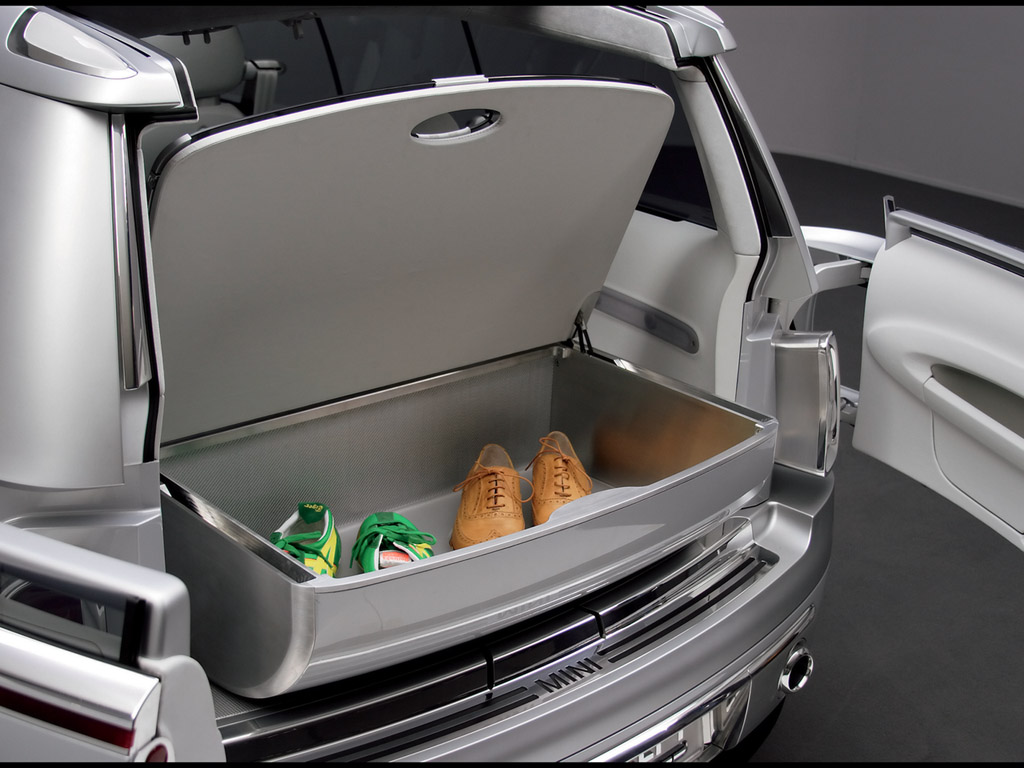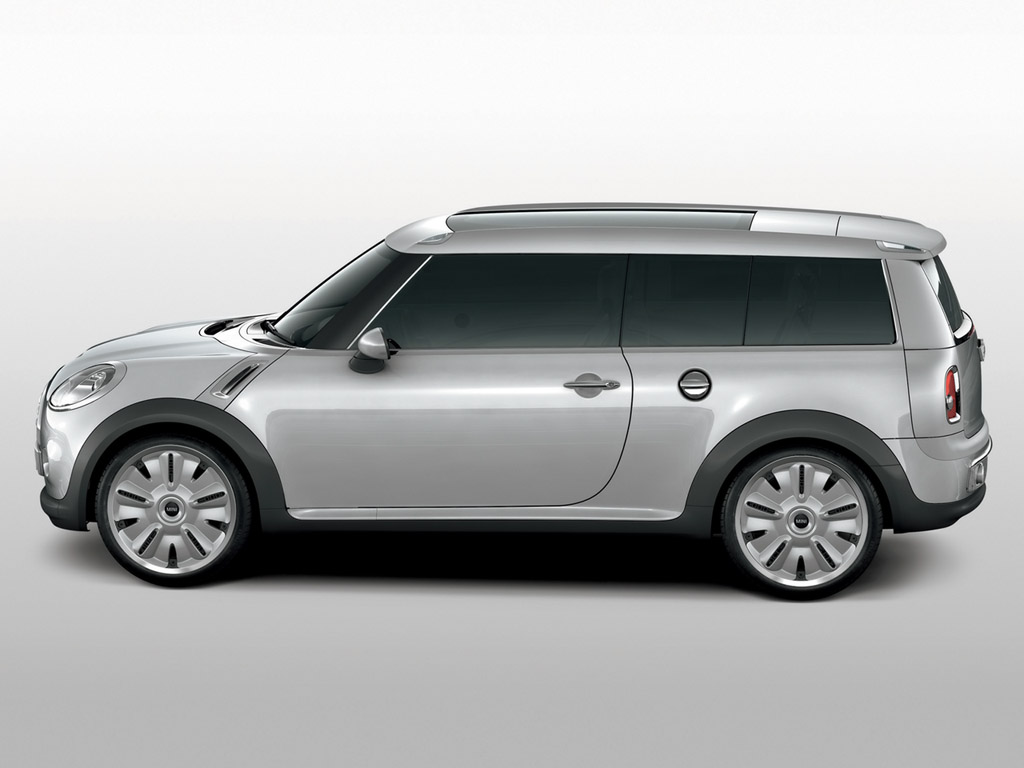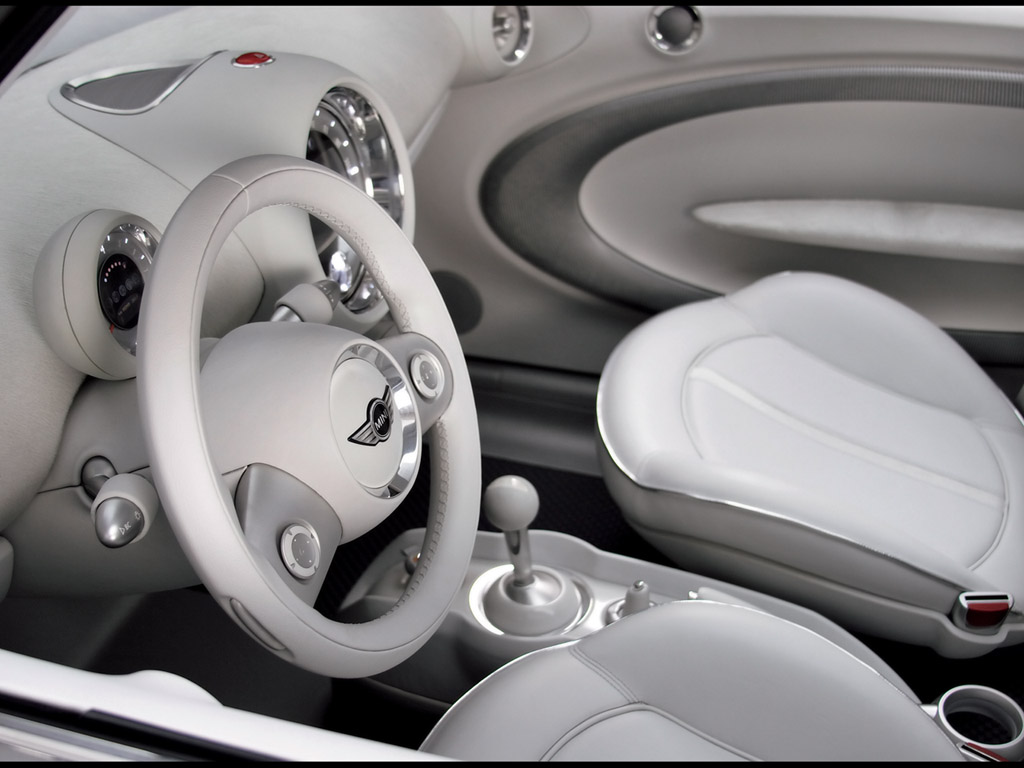2005 Mini Concept Frankfurt
(from Mini Press Release) Exactly 45 years after the launch of the Mini Traveller in September 1960, MINI is presenting the MINI Concept Frankfurt at the 2005 Frankfurt Motor Show – a design study re-interpreting the philosophy of the little Traveller from Great Britain through a new concept of “Travelling in Style” befitting the beginning of the 21st century.
In its overall look and appearance, this concept car with numerous design features in the meantime acknowledged as genuine icons is typical of MINI all the way. And numerous innovations both inside and outside are equally typical of the brand: Wide-opening doors with parallelogram kinematics characterise this very special car in the same way as its coupé-like look without a B-pillar, the new silver metallic paintwork and exquisite materials within the interior.
The MINI Concept Frankfurt also quotes the classic Mini Traveller also through its elegant Estate design boasting a symmetrically split double door at the back as well as split rear side windows.
Coupé-Like Appearance.
In its overall
appearance the MINI Concept Frankfurt is sleek and smooth, while
nevertheless placing the emphasis on important features such as the
wheel arches, the shoulder line and the powerdome. So the MINI
Concept Frankfurt makes a clear visual statement – this is a car
full of class, muscle,
and elegance all in one.
The Overall Concept – Clever MINI Style All the Way.
The fundamental idea in developing MINI Concept Frankfurt was to make loading and entering the car as simple and convenient as possible. This is why all four doors (the driver/front passenger and rear doors) come with parallelogram kinematic joints and springs: To allow optimum access and entry into the car, the doors swivel to the side and at the same time to the front in one single movement, ensuring maximum opening space leading into the interior. The rear sliding windows open electrically, the front section moving parallel beneath the rear half. With the windows fully open, MINI Concept Frankfurt thus provides a particularly impressive feeling of style and generosity otherwise to be found only in a coupé and convertible. And thanks to the long wheelbase, the two rear seats are easy to reach while at the same time the exterior of the car offers a particularly dynamic and sporting impression.
Cargobox in the Luggage Compartment, Large Loading Area in the Roof.
The MINI Concept
Frankfurt comes with an adjustable Cargobox within the luggage
compartment with its loading cover moving out to the rear for easy
and convenient access at all times. A further convenient feature is
the transparent cover on the Cargobox moving up and thus serving as
a
partition between the passenger area and the luggage compartment.
The rear section of the roof, finally, opens up just as conveniently
for easy loading.
Satellite Silver Metallic Paintwork and Neoprene Contour.
MINI Concept Frankfurt stands out in its beautiful silver paintwork in the light, all points not directly in the beholder’s line of vision being kept in a more discreet grey. Soft, resilient neoprene is featured on the black side band so characteristic of the car, extending along the side-sills and wheel cutouts.
Interior Design Characterised by “Floating Elements”.
The “Floating Elements”
concept consistently takes up and continues the car’s exterior
statement within the interior: Right from the start when getting
into the car, MINI Concept Frankfurt makes a generous and open
impression enhanced by the completely free and accessible floor of
the
car, the foot area covered only by the central “insular element” of
the centre console holding the “suspended” seats in position to
provide a particularly generous foot area with a very advantageous
impression of space.
This impression is further accentuated by the free-hovering dashboard with its speedometer in the middle.
It almost goes without saying that MINI Concept Frankfurt offers adequate space for four. The rear-seat backrests tilt down individually to form a flat surface flush with the floor of the luggage compartment, while the centre armrest lying between the two seats is integrated in the flat surface and offers additional storage space.
Leather, Chrome and Aluminium as the Principal Materials.
Throughout the interior, white leather underlines the impression of modern style and generous space, adding a strong touch of sophisticated class and stylish flair. The colour white emphasises the clear lines of MINI Concept Frankfurt, top-quality leather being used on different surfaces, the warm, natural surfaces being supplemented by cool-looking, metallic trim at all appropriate points. An aluminium-coated glass-fibre structure, for example, accentuates the door panels and linings inside the car, while a special carbon-fibre look highlights the foot area in combination with nylon texture carpeting adding a particular touch of sporting style.
Forty-Five Years of the Mini Traveller.
The four-seater Mini
with its extra-large luggage compartment was launched in September
1960 in the guise of the Austin Seven Countryman and the Morris Mini
Traveller. The term “Traveller“ alone clearly proved that this
spe¬cial version of the Mini was intended from the start for an
active target group.
Sales of the Mini Traveller from 1960 to 1982 amounted to more than
400,000 units, including a special version of the Mini Clubman as of
1969.



